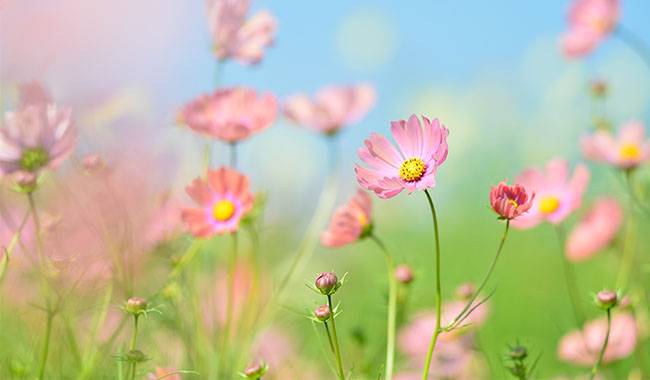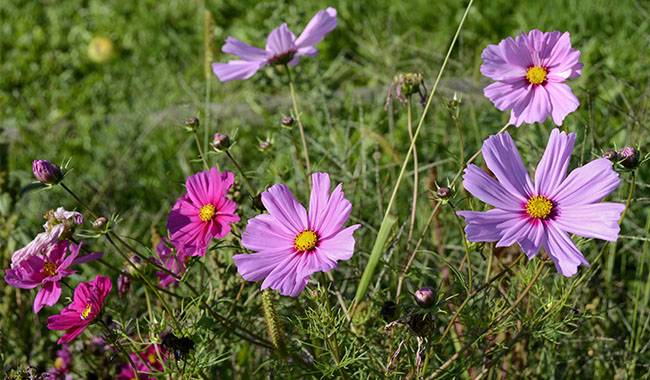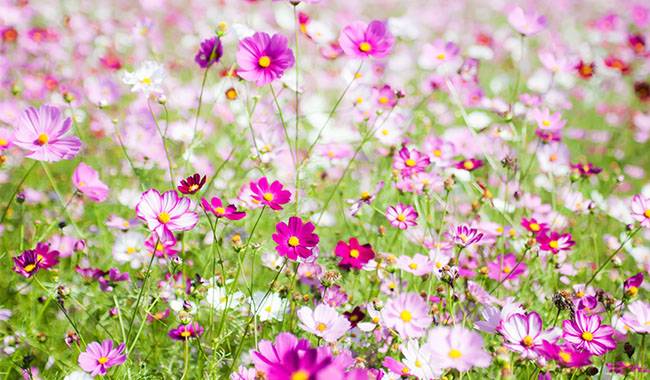
The most popular is Cosmos bipinnatus (C. bipinnatus), a native of the Mexican highlands. It soon spread to Europe because of its simplicity and ability to reproduce by self-seeding. So how do you grow cosmos? And grow from seed, planting, and care, this article has the answer for you.
Another species of this genus, C. sulfurous, also came to Europe a long time ago, but for some reason did not gain such popularity. Although it seems, its appearance should be closer to that of the inhabitants of the central United States: its yellow inflorescences are very similar to the flowers of the couch.
Both species of Persian daisies are annuals with straight and strong branches and strong branching. The inflorescences have non-punchy, semi-punchy, and punchy baskets. Cosmos bipinnatus has inflorescences up to 5inch (12.7cm) in diameter, white and pink or purple, sometimes with rings around the center.
The height is 12-48inch (30-120 cm). There are some forms of inflorescences that resemble sunflowers with ligulate flowers folded into large tubes. Cosmosulfur, 12-40inch (30-100 cm) tall, inflorescences 2-3inch (5-8 cm) in diameter, with yellow, orange, and red.
By reading our article, you will learn about which species and varieties of cosmos are the most popular methods of breeding.
How to grow cosmos seedlings and when to transplant the seedlings into flower beds.
How to care for cosmos in season and overwinter plants of perennial varieties.
BOTANICAL DESCRIPTION
The plant cosmos reaches a height of 20-60inch (50-150 cm). Its stems are slender, flexible, erect, and branched. The leaves are opposite, twice dissected, delicate, delicate.
The inflorescence is a daisy-like basket of flowers, up to 5inch (12cm) in diameter, growing singly or clustered in loose corymbiform panicles.
The flowers in the middle of the basket are small, tubular, and yellowish, while the rutabagas are large, purplish, pink, red, white, or golden yellow.
It is common to read or hear the expression “Cosmos flower” or “Cosmos Cultivation”, but this does not mean that we are talking about any particular variety, only that in recent years, breeders have developed pedunculate varieties of plant species that grow in culture for a long time.
The fruits of the cosmos are dark yellow, gray, or brown seeds. cosmos grass seeds take two to three years to germinate.
SEED CULTIVATION OF COSMOS
How to sow seeds
Cosmos flowers are propagated by seeds, either directly sown into the open ground or by the nursery method. When to sow cosmos seeds for open ground planting?
Cosmos flower beds are sown in early spring after the snow melts. Sow the seeds in a clump on the soil surface, three or four at 12-16inch (30-40cm) intervals, pressing lightly with the palm of your hand and cutting no deeper than 0.4inch (1cm).
The flowering period of seedless planted Cosmos starts in July or early August. Open sown cosmos can also be sown in late autumn and under winter. Alternatively, cosmos self-sow perfectly in autumn to propagate, simply by thinning out densely planted seedlings in spring.
SEEDLING CARE
The method of raising seedlings of Cosmos is more reliable and faster. when to sow cosmos seedlings? In March or April.
Sow cosmos seeds that are light-sensitive on top of the substrate slightly pressed into the ground, without burying the soil, moisturized, and covered with sowing film or glass.
Place the container with the seeds in a bright place. If the seeds germinate within 64-68°F (18-20°C), new shoots will appear in a week or two.
Thick seedlings should be thinned so that the distance between seedlings is 4-6inch (10-15cm) and for this purpose, picking can be done.
Sprouted seedlings should be grown at a lower temperature of 60-64°F (16-18°C). If you do not want to bother with seedling picking, you can immediately sow two or three seeds in separate cups.

COSMOS PLANTING
When to plant
Cosmos can be planted in early June when it is past the return frost and the seedlings have grown to 2.5inch (6cm). If you are sure that the cold weather will not return, planting in mid-May is allowed.
Find an open, sunny, sheltered spot with fertile, well-drained, slightly acidic soil to plant cosmos.
Overly fertile soil promotes green growth, but unfortunately, the quality and intensity of flowering will suffer.
HOW TO PLANT COSMOS
So, in mid-May or early June, when the warm weather finally arrives, prepare shallow holes in the garden according to the 30×30 scheme, or 35×35 if you want to plant high-growing varieties, and water them.
Then put the seedlings in the holes, dig them and water them. Don’t forget that very tall cosmos plants may be unsupported, so dig around the wood or sticks when planting seedlings in advance.
When the cosmos reach 20inch (50cm) in height, trim the tips of the buds to shrub them better. If the cosmos is planted as a seedling, it will bloom in June or mid-July.
COSMOS CARE
Planting conditions
Growing and caring for the cosmos is easy even for beginners. Water cosmos once a week and it should be abundant – four to five buckets of water should be poured under each bush.
After watering, the plot is loosened and weeds are removed until the cosmos becomes a mature and strong plant. Fertilize three times a season with a flowering plant fertilizer: before flowering, at flowering, and at flowering.
For richer blooms, you can make the preparation spray on the leaves, but when fertilizing cosmos, remember that moderation is needed in all things. Remove wilted flowers in a timely manner.
If the shrub in the flower bed becomes very sprawling, it can be pruned so that it does not stop flowering and will look more compact and beautiful.
Here, in fact, is everything you need to know about growing cosmos flowers.
PESTS AND DISEASES
Cosmos is very immune to pests and diseases and is almost unaffected by them. Threats come only from slugs and snails, and that’s before the plants take root.
You will have to fight them off by collecting mollusks by hand. Distribute pots of beer around and collect the occasional crawling gastropod.





